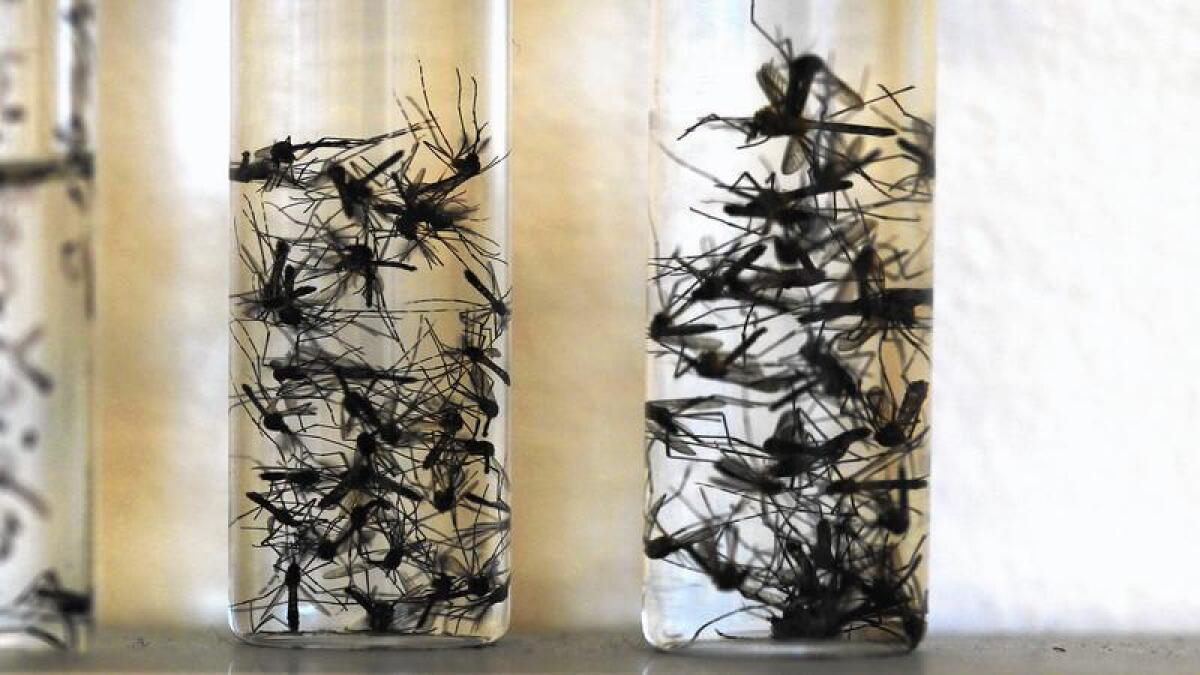California will see a lot more disease-carrying mosquitoes this year, experts say

The yellow fever mosquito, trapped in vials at the San Diego County Vector Control lab, and the Asian tiger mosquito have both been found in parts of California.
- Share via
Two types of nonnative mosquitoes that can transmit potentially fatal diseases have spread throughout California, and their populations could explode come spring.
The mosquitoes’ expansion of territory was largely attributed to abnormally warm weather in the summer and fall.
“It was quicker and more widespread than any of us could have anticipated,” said Chris Conlan, an ecologist with the San Diego County Vector Control Program.
The yellow fever mosquito (Aedes aegypti) and Asian tiger mosquito (Aedes albopictus) can carry diseases linked to birth defects, painful illness and tens of thousands of deaths around the world each year.
The mosquitoes can be identified by their black-and-white striped bodies and aggressive behavior toward people, often following them indoors. These pests are smaller than average mosquitoes and distinguish themselves as daytime feeders. They’re tough to eradicate, needing as little as a thimble of water to reproduce.
After months of tracking the growing population of yellow fever mosquitoes, local vector-control officials found the Asian tiger mosquito in September. Both species of the insect were first found near San Diego’s shipyards, although it’s unclear how they first came into the county.
“In many cases, when the technicians go out ... to respond to complaints [about the mosquitoes], they’re even swatting them out of their face,” Conlan said. “In a couple of places, it has reached very troubling numbers — San Ysidro and some areas around Barrio Logan to Logan Heights. It’s pretty widespread down there.”
See more of our top stories on Facebook >>
So far, California has seen no locally acquired cases of disease spread by these mosquitoes, which include dengue fever, yellow fever and chikungunya. Disease spreads when infected travelers come to the state and are bitten by mosquitoes.
Last year, there were 99 cases of dengue and 178 cases of chikungunya reported in travelers returning to California. There were no reported cases of yellow fever.
West Nile virus remains a more immediate threat among mosquito-related illnesses, but that could change, said Marco Metzger, senior public health biologist in the vector-borne-disease section at the California Department of Public Health.
“What we’re dealing with is an emerging concern,” he said. “If these [mosquitoes] become widely successful in California, we have the potential for disease transmission.
“We don’t have any mosquitoes that live so closely associated with humans. These mosquitoes are notorious in so many parts of the world because they live with us.”
Public health officials are urging residents who see these invasive pests on their properties to take action before temperatures heat up. Mosquito season usually starts in March and peaks between August and November.
With a limited flight distance, the mosquitoes likely breed near where they’re spotted. The saucers of potted plants, plastic toys that fill with water and clogged rain gutters offer fertile breeding opportunities. The mosquitoes’ eggs can survive without water for months, requiring infested sites to be scrubbed down thoroughly.
“For these guys, more so than ever, we really need the public’s help in eliminating the standing water sources to make sure they don’t become more of a problem,” Conlan said.
First found in California in 2013, Aedes aegypti and Aedes albopictus have roughly tripled in number around the state during the last several seasons. They have been found in 82 cities and communities, including Escondido, Los Angeles, Fresno and parts of the Bay Area.
But beyond being a growing public nuisance, it’s unclear how much of a threat these mosquitoes present. East Coast and Midwest cities have long tolerated the pests without serious incident.
Although Mexico and the Caribbean have suffered the effects of dengue and chikungunya for some time, less than a dozen people in the contiguous United States, all in Florida, have ever become sick from being bitten by a mosquito carrying either disease.
Yellow fever has been largely confined to tropical areas of South America and Africa. A vaccine for travelers has significantly limited transmission of the disease into Western countries.
Meanwhile, a virus linked to the mosquitoes known as Zika has spread throughout Brazil, causing thousands of cases of brain damage in babies born with abnormally small heads. But the United State has never had a recorded case of Zika.
Still, public health officials warn that it’s better to be vigilant about prevention.
“The concern is that if and when these mosquitoes become well-established in the state and abundant in our neighborhoods, then the risk of transmission increases,” Metzger said.
Joshua Emerson Smith writes for the San Diego Union-Tribune.
ALSO
First in series of storms forecast for Southland expected to hit overnight
Domino’s Pizza employee arrested in stabbing of customer angered by delivery ‘delay’
California lawmakers return to the Capitol to tackle leftover business
More to Read
Sign up for Essential California
The most important California stories and recommendations in your inbox every morning.
You may occasionally receive promotional content from the Los Angeles Times.









